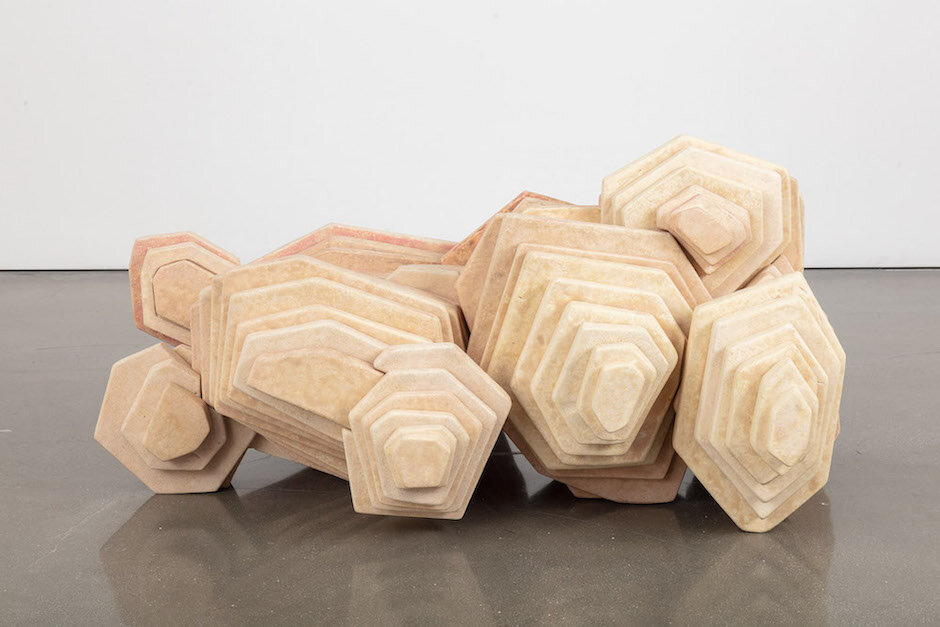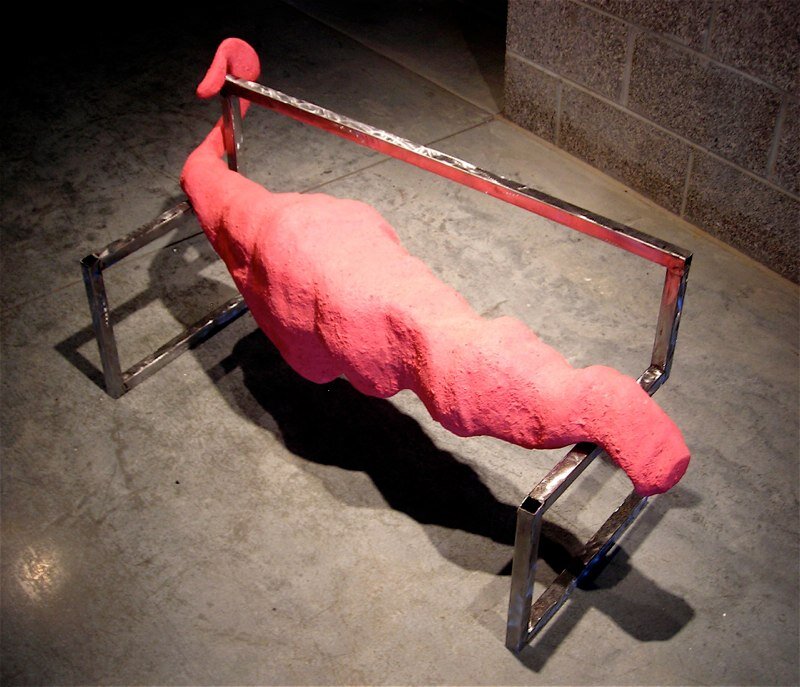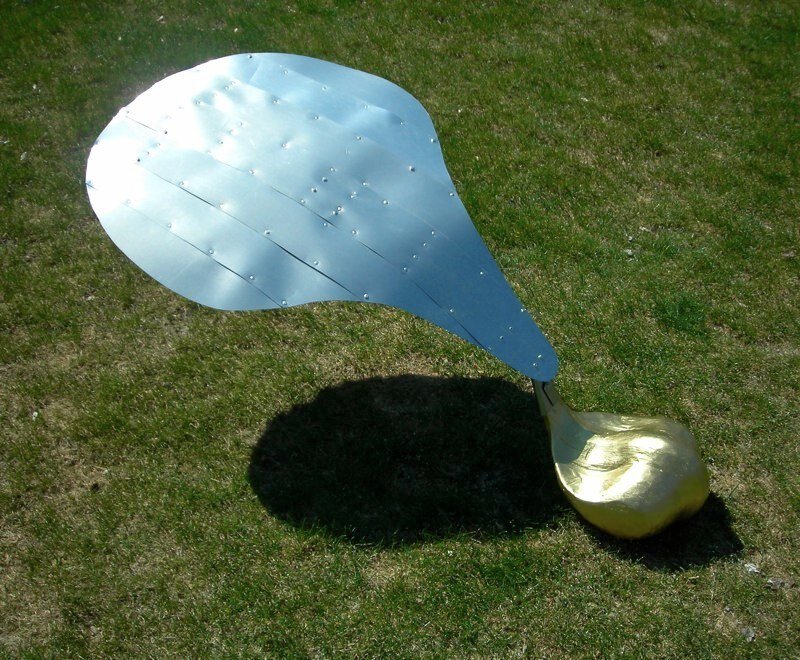
ARTS 160
Beginning Sculpture
Fall 2023
M/W 2-3:50pm
FCVA 124
Welcome to the home page and syllabus for ARTS 160 Beginning Sculpture. Here you will find all the resources you’ll need to immerse yourself in thinking and making this semester.
This course acquaints students with a set of materials, texts, and critical discourses that articulate the historical and contemporary concerns of sculpture. Guided by formal and conceptual considerations, students generate sculptural objects and installations in a variety of media. Lectures, readings, discussions and critiques surround and foster the hands-on making process.
Office Hours: Friday 1-4pm
Zoom: https://whitman.zoom.us/j/2208648525
Much has happened technologically and culturally in the course of the late 20th and early 21st centuries to alter the traditional parameters of art making. Together we will examine crucial pivots and revisions, endeavoring to understand “extra-artistic” and internal forces that shape the landscape in which contemporary sculptural gestures are made.
Artists are engaged in some of the most exciting research around--research into what it means to be alive and human right here and right now. Art, if you let it, will blow your hair back, get your heart revving, and even make your skin tingle. My teaching celebrates this through experimentation and exploration; it’s not art if there isn’t risk-taking, trial, error, revision, frustration, failure and epiphany. Art is messy. Art is hard. I understand the classroom as a dynamic space, full of emergent and sometimes radical possibility. That said, it is always a collective space, where we can all benefit, support, encourage and challenge each other’s most genuine endeavors. A spirit of cooperation befits this and I exhort you to contribute to it. The quality of your presence and attention to course content is indispensable.
ME + YOU I have conceived an overall architecture for the course, but I am also excited to tailor our investigations to our interests and needs as they evolve and present themselves. I expect you to make a serious and sustained effort to wrestle with the ideas proffered, to take notes during lectures, to come prepared to actively discuss readings or assigned videos, and to spend time at least twice during the week to further your projects outside of class. It will be important to develop habits of mind that keeps you moving forward and connected to the course goals at regular intervals, rather than making binge-y, spastic, all-or-nothing gestures constrained heavily by time, i.e. “cramming” an art work into being.
Please feel free to be in contact with me as much as you need: in class, during office hours, via email. Like most folks, I can get overwhelmed by email and therefore need to practice good boundaries with it, so please give me 24 hours to respond in that way. Also, I’ll expect you to check your email once every 24 hours or so, because I’ll occasionally want to communicate via this medium (about assignments, materials, etc.) and need to rely upon the certainty of your being on the other end of these electronic missives. Thank you, in advance!
Last but not least, this syllabus functions contractually, and as such delineates course objectives, expectations and obligations. You are responsible for the information herein, so please take time to read through this document carefully.
PEDAGOGY This course is driven by relationship-centered pedagogy. That means we will privilege the relationships we have with each other and as a group, and strive to make connections between course content, materials and larger intellectual themes. Because we are operating within the context of various and interconnected local and global crises (ecological, social, racial, ideological, to name just a few); I sincerely commit to honoring the strangeness of this time with all of its possibilities, limitations and unknowns. As the writer Rebecca Solnit recently said, “we may be in the waterfall part of the river.”
Many aspects of art simply cannot be taught. That said, we will work to tap into places of intuition, creativity and mystery that fuel great human achievements, which sometimes take the form of art. Mostly, making art is simply a way of thinking—a way to construct knowledge from experience.
GOALS AND OBJECTIVES
- Develop 3-D visual thinking and making skills. The hand knows things that the mind does not!
- Understand the techniques and processes related to individual media. Get into a complicated relationship with matter!
- Hone your ability to assess and interpret 3-D forms, conceptually and formally. Cultivate intuitive, irrational, emotional, embodied intelligence!
- Develop an aesthetic vocabulary informed by the Visual Elements and Principles of Design. Yup.
- Become acquainted with the critical discourses that articulate the historical and contemporary concerns of sculpture. Indeed.
- Take creative risks, experiment, fail, succeed, and repeat. This!
- Think divergently. Make radically. Yes, please!!!
PROJECTS
Object Translations - introduction to sculptural issues of scale, material and latent content.
Hard Empathy Meme - our collective attempt to embody and transmit Dr. Jane McGonigal’s concept of “hard empathy”.
Project #1 - Figuring The Body (20 pts.) Working in the language of moldmaking as both ancient and contemporary technique, we will pull plaster molds from manikins, the human body, and other objects to build out and discover how material behavior, accident, and process produce sculptural thinking.
Project #2 - Constructs + Materials (20 pts.) The middle section of the course is dedicated to formal skill building and experimentation in wood and metal (material studies). This includes exploration of different types of joinery, structures, surfacing, cutting and shaping techniques, as well as a corollary examination of the purely abstract and metaphorical possibilities inherent in materials.
Material Studies: Joints, Lamination, Agglomeration, Volume. (5 pts. each)
Project #3 - Sculpture as Dialectic (20 pts.) Your final project is a work realized by putting two ideas OR materials (of your choice) into conversation with each other such that the final form is a synthesis of of both parts: Thesis + Antithesis = Synthesis
Dream Journal - During our semester together I invite you to tune into the dreams that present themselves to you at night, and to think of these as a kind of culturally/personally significant source material. I keep a book in the classroom where you may share aspects of your dreamworld. This is NOT a requirement, purely an invitation to presence the unconscious. Often, images and objects originate here and knowing this can further illuminate our exploration. (You will NOT be penalized grade-wise if you can’t remember your dreams and/or choose not to share them.)
EVALUATION Course prompts and daily activities are designed to develop your creative muscle, enlarge your knowledge of contemporary artists, and activate your imagination in totally new and divergent ways. This course focuses thematically on how Ideation, Process and Interpretation unfurl in a 3-D context. All final works will be considered according to the following criteria:
1. Visual Power: Makes you want to look at the work; form demonstrates visual interest, surprise, intrigue; has a potent subject; evidences imagination and creativity.
2. Transformation: Works to alter the viewer’s perception in some way, materially, formally; suggests a new thing; the Piggyphant!
3. Design: Effectively employs visual logic and language; utilizes Principles of Design to organize the Visual Elements.
4. Craft: Attention to the inherent properties and personality of the material, engaging and responding to how it behaves, latent cultural and/or psychological resonances it carries.
5. Critique: Active participation, commenting and questioning; effective installation of the work.
6. Classroom Presence: Daily clean up of studio; quality of attention and work in class; peer-support and attention to others.
7. Work Ethic/Process: Evidence of a variety of attempts to discover, experiment, resolve; development of ideas over time; overall effort and attention to process.
*response to critique: if you make a substantive alteration to your project within 5 days of the critique, based on feedback received in the critique, you can improve your grade.
YOUR GRADE = PROJECTS (60 points) + PROCESS (15 points) + PRESENCE (25 points) = (100 points)
PROCESS = everything that leads up to a work; PRODUCT = design, craft, imagination manifest in the final piece.
Process is paramount in artmaking. Dedicated development of your ideas, exploration of a variety of options, and patient consideration will yield the most extraordinary results. By “process,” I mean the development of your ideas in sketches, maquettes and in concept. As a general rule, persistence and deep attention offer ample pay-off. At other times, you will need to submit to the irrational forces of intuition and madness, heeding the unique screech of sirens and muses.
The formal choices that you make about size, scale, shape, color, material, etc. ARE the content of your work. Close attention to the Visual Elements and Principles of Design will yield the greatest synthesis between FORM and CONTENT. By “product” I mean the final work, its formal success and achieved meanings as delineated by the assignments, and in conversation with the fundamental concerns of sculpture, historical and contemporary.
The relationship you build with sculptural materials generates the knowledge and skill that allow you to transform raw matter into sculpture. Craft is both the physical and intellectual skill you bring to the work.
Thinking IS making in sculpture. In addition to presenting a variety of physical/creative problems to solve, course content will include discussion of influential technological, social and cultural forces that have impacted artists and art making over the last 100 years. Your work AND the discussion of said work should evidence engagement with these ideas.
PRESENCE I use the term Presence to indicate your performance in the studios with regard to participation, work ethic, cleanup, organization, and safety, in addition to a measure of the quality of your engagement with the meat and bones of this course’s intellectual content. This later entity shows up in partner work, class discussion, attendance, the quality of your labor, the persistence of your process, and in oral and written critique. Our attentiveness to the larger learning environment/culture and collective intelligence that we generate (or thwart) is something we will tend to throughout the semester. Sculpture requires a particular kind of mindfulness, presence, and an ability to execute from places of intuition/embodied intelligence. We will cultivate these during our time together.
RITUAL + CEREMONY I approach the classroom as a performance, play and at times sacred space, wherein we will cultivate a transformative quality of focus and attention. Arriving to class on time is an essential part of this process.
TRUST, CONSENT, RESILIENCE, SAFETY and TRAUMA are current culturally resonant concepts that we will want to keep in mind as we navigate our making, dialogues, and interpretations. Ultimately, no 100% safe space exists, but we can clearly set our intentions to care for each other to the best of our ability. Learning should be transformative. Which means it might make you uncomfortable at times. We’ll set the tone for these ideas as we work out our Community Agreements together and re-visit them as necessary throughout the semester. I’m an advocate of the hard labor of transformative justice and believe deeply that conflict can be very generative when carefully and thoughtfully navigated.
THOUGHTS ON POWER, REPRESENTATION AND HISTORY Art and artists are indispensable to a well-functioning democracy. Democracy requires imagination and flourishes when the imaginative life of a society is cultivated and nurtured. We can only create that which we can imagine, whether our creations are works of art, engineering, public policy, etc. I therefore strive to maintain a classroom that is deeply respectful of differences in ideas, opinions, strategies, and experience. Yet the history of art is affected by the same historical operations of power that play out in the world at large. Cognizance of the ways race, class, gender, sex, ethnicity, religion, age, ability, national origin, and sexual orientation inform our making and interpreting is crucial to our intellectual inquiry. I seek to know and carefully navigate the ways artistic representation makes power and privilege visible. This can be tricky, but again, I endeavor to build a community in which we ask hard questions about how the history of images and objects shapes our experiences, desires and sense of the possible.
Building this awareness will assist the effort to decolonize the curriculum.
I would be remiss to fail to acknowledge that the forces of empire in their different guises (genocide, slavery, white supremacy and misogyny) have conspired to allow us to inhabit this room on this campus on this land. I do so with the hope that consciousness of these agents can lead us away from their perpetuation.
The imagination is truly our greatest berm to tyranny!
CRITIQUES: Critique is a format for discussing work (or, re-making the work in words) which happens in a more or less public way. Critiques can take many forms, including group-wide scenarios, peer/partner critiques and even written reviews. Often they utilize free-association, but they function best when the criteria for analyses are clear. You will be on both ends of the critique, giving and receiving feedback. At the most basic level our interest will be in learning how visual language functions, and therefore, how you can better wield it for certain effect. All artworks make arguments and utilize visual rhetoric to do so. But art also traffics in language that is purposefully ambiguous, historically situated and slippery. Meaning functions in ways that are often not rational or literal but instead oblique, associative and evocative. Interpretation happens best at the deep end of the pool and we will spend a good amount of time there.
LATE WORK: Projects unfinished by the designated time are extremely discouraged and will suffer commensurate reduction in the project grade. Project grades will incur a penalty of 5 pts./day, unless we reach an agreement otherwise. Please communicate with me asap if you anticipate not being able to complete an assignment on time.
STUDIO ACCESS and USE: The main classroom of the Sculpture area is available for your use from 8am to 10pm, every day of the week. Access to the Wood and Metal Shops will be restricted to times when a trained Monitor can be present, or I or the Safety Tech Ben Selby can accompany and/or oversee safe use of materials and machines. Your Whitman ID will have card swipe access during the semester; please let me know if your card swipe fails to work (sometimes this happens).
The Sculpture Studios will be monitored on certain weeknights and weekends by Sculpture Studio Monitors. Please take advantage of these students and avail yourself of their knowledge. Please always respect a Studio Monitor’s judgment around safety in the shops and yield to their experience. They have your safety in mind above all else.
You may email me or Ben Selby to arrange a time outside of monitored hours to come in and use the facilities. Because our schedules are often quite full I encourage you to arrange these sorts of meetings with at least 48 hours of anticipation.
OFFICE HOURS I’m available to you during our class time and at other times through the week when you may need assistance with course content/assignments; please email me if you need to meet outside of our regular time slot; or come to my office hours on Fridays from 1-4pm, when I am typically helping students in the Sculpture area. We can chat about the course, college more generally, careers, current events or whatever. Do not feel like you need a so-called “good” question – please come by the studio to see what we are up to or even just to say “hello”!
DAMAGES: Any damages to the art building, the tools and or machines herein, may result in charges beyond the course fee, to your student account.
CELL PHONE USE: Personal cell phone use is not appropriate in this space. We will make a habit of putting our phones in a basket at the beginning of class in exchange for a rock.
ATTENDANCE/TARDINESS: Prompt and consistent attendance is crucial and your success in this class will depend largely upon it. I take attendance daily and the quality and quantity of your attendance will be reflected in your Presence grade. You are required to seek missed notes from a classmate and make up hours missed in the studio. When/if you are absent you should plan to visit with me during my office hours on Friday afternoons between 1-4pm to make sure you stay on track.
***Missing a class Demo is something you really, truly want to avoid. Big demos are accompanied by short but contextualizing lectures and activities. These provide far more than technical information alone. If you miss certain Demos (Wood Shop, welding, moldmaking, etc.) you will need to find time outside of class where you can receive information from me or Ben Selby BEFORE you will be allowed to access the facilities and use the materials associated with the Demo.
Absences will have the following effect on your grade:
Missing 5 classes = you will no longer be able to earn an A in the course;
Missing 7 classes = you will no longer be able to earn a B;
Missing 9 classes = you will no longer be able to earn a C;
Missing 10 classes can result in automatic failure of the class; at this point the ability to successfully complete the course is thrust into serious doubt for me. In the event of extreme circumstances, I reserve the right to make exceptions to these rules in consultation with the Dean of Students and/or Provost. That said, I exhort you to proactively guard your physical and mental health in every way possible, and to document if/when you are unwell.
Often, at the beginning of class I make important announcements and set up the schedule of activities, answer questions, or reflect on our direction and progress. Routinely missing the first 5-10 minutes is unacceptable and will severely impact your Presence grade.
WORKLOAD: A modicum of success in this class will typically require 4-6 hours of work outside of class time per week; this includes working on class projects, readings/videos, etc.
Art making is not a linear process, and artworks cannot be crammed overnight; this dictum applies especially to material based works, which are supremely subject to laws of physics, skill and the functions of time and space.
CLASS STRUCTURE: Our time together will be structured by studio time, short videos, lectures, group and individual activities, critiques, and thinking through/together, writing and discussing art, artists and ideas.
COURSE FEE: $150 (This fee covers all of the materials you will use in this space, maintenance and replacement of broken items, etc.)
SAFETY: Works involving bio-hazardous materials, body fluids, egregious physical or emotional pain, or weapons will NOT be permitted in class. If you have ANY concerns regarding the safety of a material or process or project, you are required to consult beforehand with me. Let your guiding principle be “do no harm,” physically to the building, yourself, grounds, facilities, etc. or emotionally to yourself/others. While some actions may be intellectually defensible within the history of art, there are limits to what I will allow to happen in my classroom, virtual or otherwise, for our mutual emotional and physical safety.
CHANGE: I reserve the right to alter or modify this syllabus as we proceed through the weeks of the semester.
ACCOMMODATIONS: If you are a student with a disability who will need accommodations in this course, please meet with Julia Dunn, Associate Dean of Students (Mem. 205, X5213, dunnjl@whitman.edu) for assistance in developing a plan to address your academic needs. All information about disabilities is considered private; if I receive notification from Ms. Dunn that you are eligible to receive an accommodation, I will provide it in as discreet a manner as possible.
In accordance with the College’s Religious Accommodations Policy, I will provide reasonable accommodations for all students who, because of religious observances, may have conflicts with scheduled exams, assignments, or required attendance in class. Please review the course schedule at the beginning of the semester to determine any such potential conflicts and let me know by the end of the second week of class about your need for religious accommodations.
Janine Antoni
Antony Gormley
Thomas Houseago
David Altmejd
David Altmejd
Kiki Smith
David Altmedj
Thomas Houseago
Urs Fischer
Project #1 Figuring the Body
Moldmaking is one of the foundational techniques in traditional sculpture, allowing you to make copies and/or multiples of objects. They can also serve more than functional ends, and may possess intrinsic visual power of their own. Understanding how molds function will also teach you how to isolate and attend to shapes themselves, another bedrock element of sculpture.
Artists:
Diana Al-Hadid
Kiki Smith
Janine Antoni
David Altmejd
Project # 2 Constructs + Materials
This middle section of the course is dedicated to formal skill building and experimentation in wood and metal. This includes exploration of different types of joinery, structures, surfacing, cutting and shaping techniques, as well as corollary examination of the abstract and metaphorical possibilities inherent in materials.
Artists:
Martin Puryear
Ursula von Rydingsvard
Leonard Drew
Liz Larner
Student work:
Project # 3 Sculpture as Dialectic
Contemporary sculptures partake of an unlimited number of possibilities in material terms, and works often resonate through a conglomeration of references and allusions. Using found objects, strange materials, and from low to high and everything/where in between, sculptors make materials converse in totally new ways.
Artists:
Rachel Harrison
Ai Wei Wei
Allora & Calzadilla



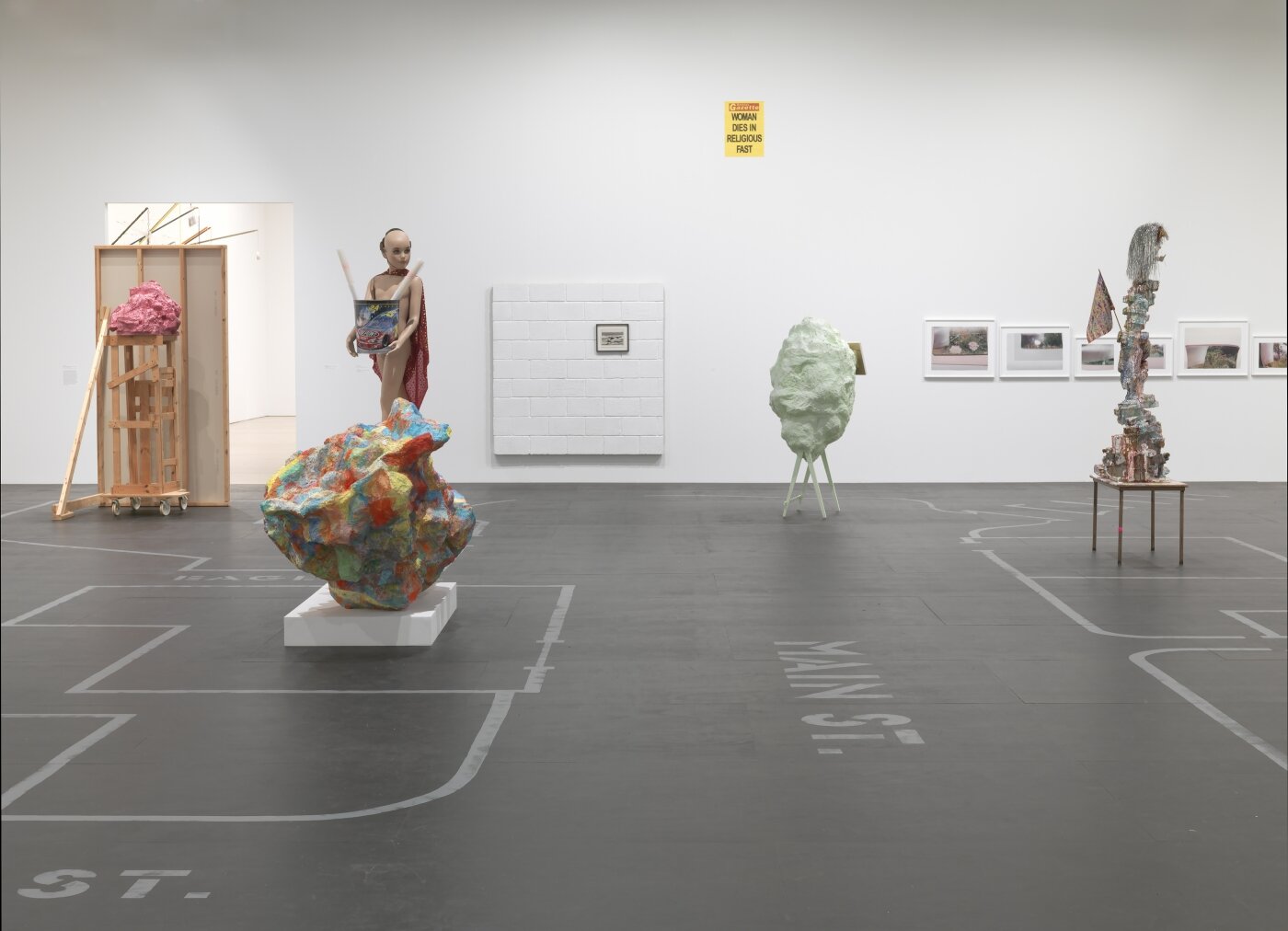






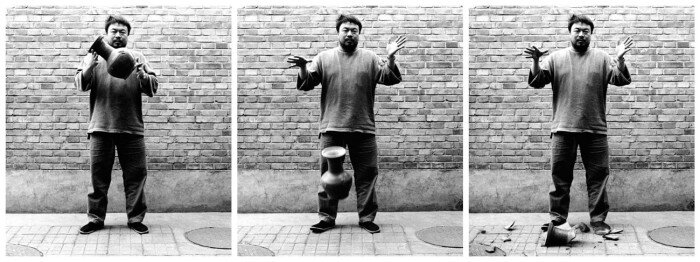


Calendar
Week 1
Wednesday, August 30
Welcome, Course Introduction, Tour, Info + Relations
ACTIVITY: Object Translations + making our first exhibition
ACTIVITY: Hard Empathy + Imagination - Jane McGonigal on the Future: https://www.youtube.com/watch?v=P5Z20RVq5dA
HOMEWORK: for Monday: Complete your Info + Relations sheet and bring it back with you to class. Explain the Hard Empathy concept to friends and ask them to join you in performing it somewhere on campus. Locate the three campus sculptures, spend some time with them (even just 5 minutes), get a sense of what you thinkfeel about these works. Look through Sculpture magazine and find your Favorite Thing.
Week 2
Monday, September 4
TURN IN: Info + Relations sheets
SHARE: experiences of Hard Empathy exercise, Favorite Thing
ACTIVITY: Sculpture Walk in threes, meet up at Carnival at 3pm
HOMEWORK: for Wednesday watch David Altmejd’s ART 21 video segment and come prepared to discuss the following:
David Altmejd doesn’t “do sketches,” preferring to work directly in materials; can you imagine what your own approach might be, and what might be some of the benefits and/or drawbacks of developing sketches or models?
Altmejd states that he’s not so much interested in learning a language but rather in “inventing languages,” which he feels he is able to do in art. What do you think he means?
Altmejd vehemently disses thinking about work as a “mere illustration” and says he’s specifically going for the development of “complexity, layers, references and energy in the work” so that it comes alive and “develops the capacity to generate its own meaning.” What word would you put in opposition to “illustration” when trying to describe what artworks do that goes beyond illustration?
What does Altmejd mean when he says, “the sculpture says things I never thought”?
Check out some of his artwork here.
Wednesday, September 6
ACTIVITY: Establishing our Community Agreements, sharing more about our Relations + Info
DEMO: working with plaster gauze
HOMEWORK: make two shellcasts from 2 different body parts and join them together to create one single sculpture. NO HANDS!!!!!
Week 3
Monday, September 11
ACTIVITY: look at the works you’ve made together.
HOMEWORK: Before Wednesday’s class: WATCH: Art 21 on Janine Antoni
Think about these specific works and be prepared to analyze their content:
Moor - all the different materials and lives are subject to the same treatment--braiding. What meaning does the braid form suggest?
Eureka - This piece re-enacts Archimedes discovery of the formula for calculating volume. The body was very much the “tool” used in that thought process/discovery, just as Antoni uses her body to make the work. Why do you think she chooses lard? What association does that material carry?
Loving Care - How we choose to make something has EVERYTHING to do with its meaning. Let’s analyze Antoni’s choice of material (hair dye), gesture (swishing her hair across the floor) and title (hair care product); what ideas are produced from these three choices?
Wednesday, September 13
DISCUSS: Janine Antoni works.
DEMO: Mold Theory
HOMEWORK: WATCH: Art 21 on Kiki Smith
Come prepared to discuss: Smith argues that art making is “something that moves from your inside to the outside” and in this, that “art is a way to think”. Art comes out of one’s individual, subjective experience, yet it also moves beyond it. Where do you see this in her work? Smith takes lots of risks, materially and emotionally, especially in the subjects she often chooses to represent. Her works center the body and its many vulnerabilities, and confess a certain level of discomfort.
Week 4
Monday, September 18
Come to class with 2 plaster experiments, one mold and one cast. Be ambitious! Be conscious of both positive and negative space. Search for the Piggyphant! Try to see something new!
DISCUSS: Kiki Smith video
Wednesday, September 20
WORK DAY - Project #1 Figuring the Body assignment
HOMEWORK: Read Sun Magazine essay: Out of Our Heads
Week 5
Monday, September 25
DISCUSS: Out of Our Heads
In class: Mark Quinn video
WORK DAY
HOMEWORK: WATCH: Art 21 on Diana Al-Hadid
Al-Hadid who states, “the work I make mostly starts with not knowing what I’m doing…I surrender to that.” She also says, “I want to know what I don’t know”, and that she wants to “know the limits of her thinking.” Where are these ideas living in your own investigations?
Wednesday, September 27
DISCUSS: Diana Al-Hadid
WORK DAY - get feedback on your project!
Week 6
Monday, October 2
FIRST PROJECTS DUE - Critiques
Wednesday, October 4
Critiques in class
HOMEWORK: watch Art 21 videos for Leonard Drew and Ursula von Rydingsvard
Week 7
Monday, October 9 (Indigenous People’s Day)
DISCUSS: Art 21 videos
Begin Project #2 Constructs + Materials
DEMO: making simple joints
Wednesday, October 11
HOMEWORK: Material Exploration - How Do Things Fit Together? Make a closed 3-D form with exactly 20 pieces of wood and 10 joints. One side of the form must be at least 1’ in length. Project due on Monday!
Week 8
Monday, Oct. 16
How do Things Fit Together? projects due
HOMEWORK: Material Exploration - Density Using wood scraps cut and shape and assemble an object that builds a density of form and mass, through agglomeration. Be a wood scrap monster! Be voracious! By next Tuesday, have a work that measures at least 2’ in one direction.
Wednesday, Oct. 18
WORK DAY
DEMO: dremels, chisels, spindle sander, chain-making
WORK DAY
HOMEWORK: watch Art 21 videos for Martin Puryear and Liz Larner
Week 9
Monday, Oct. 23
DEMO: Metal Shop
HOMEWORK: Material Exploration - Spacemaking! using a 10’ length of steel strap, make an object that contains space and articulates a volume. Abstract work only. Due Monday, Oct. 30
Wednesday, Oct. 25
DEMO: Metal Shop con’t
Week 10
Monday, Oct. 30
WORK DAY
HOMEWORK: Material Exploration - Odd Couples - When Wood and Metal Meet using steel rod or wooden 1x2’s, make a mate for one of your other Material Explorations, so that a wood form and a metal form live together in one piece.
Wednesday, Nov. 1
WORK DAY
Week 10
Monday, Nov. 6
DEMO: riveting, aluminum
Wednesday, Nov. 8
DEMO: finishing
Week 11
Monday, Nov. 13
SECOND PROJECTS Odd Couples Due - Critiques
Wednesday, Nov. 15
Critiques
HOMEWORK: before class, watch/look at the following artists:
Doris Salcedo Art 21
Allora & Calzadilla Art 21
Week 12
Monday, Nov. 20
Presentation of Final Project Prompt: Sculpture as Dialectic
DISCUSS: Salcedo and Allora & Calzadilla
NO CLASS ON WEDNESDAY - I’ll be with seniors in NYC!!!!!
Happy early Thanksgiving break!!!!!
HOMEWORK: read Rachel Harrison and watch Ai Wei Wei Art 21
Continue ideation for Sculpture as Dialectic
Week 13
Monday, Nov. 27
DISCUSS: read Rachel Harrison and watch Ai Wei Wei Art 21
WORK DAY
Wednesday, Nov. 29
WORK DAY
Week 14
Monday, Dec. 4
WORK DAY
Wednesday, Dec. 6
THIRD PROJECTS DUE at the beginning of class.
Classroom Clean-up and Critique!!!!
Week 15
Final Exam Week
FINAL CLASS MEETING: Friday, Dec. 15 9-11:00am Course wrap-up, final thoughts.
Made with Squarespace












